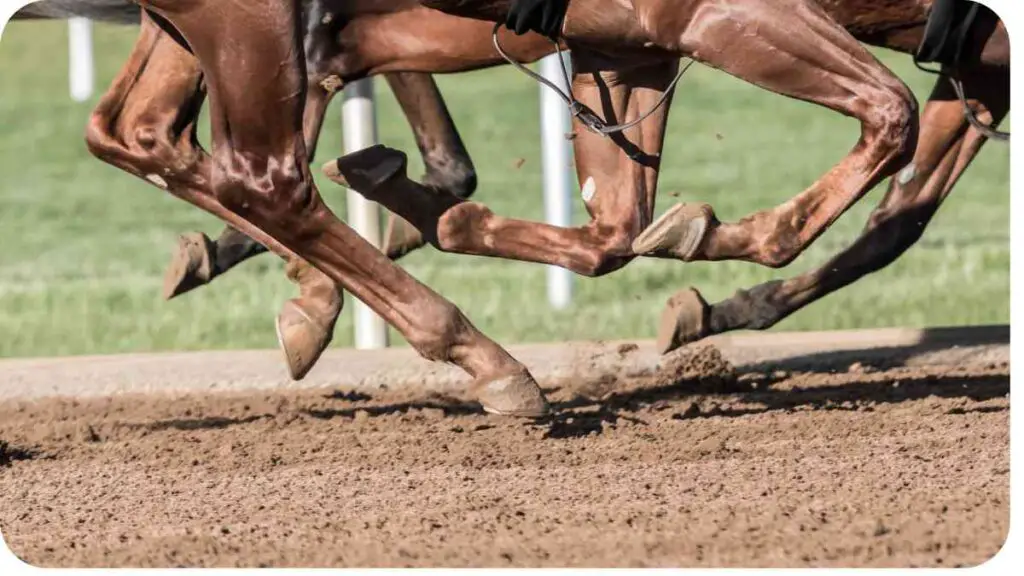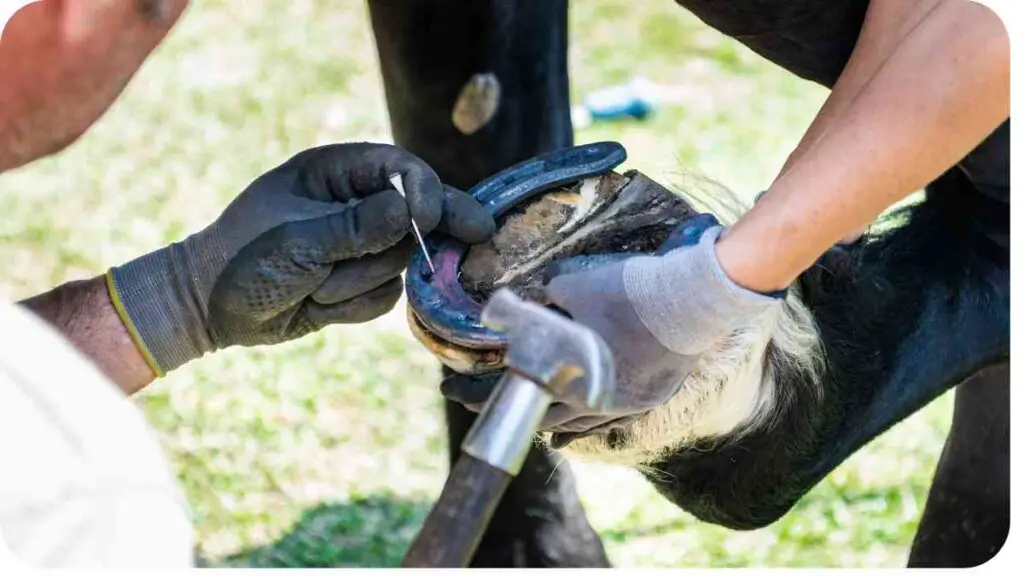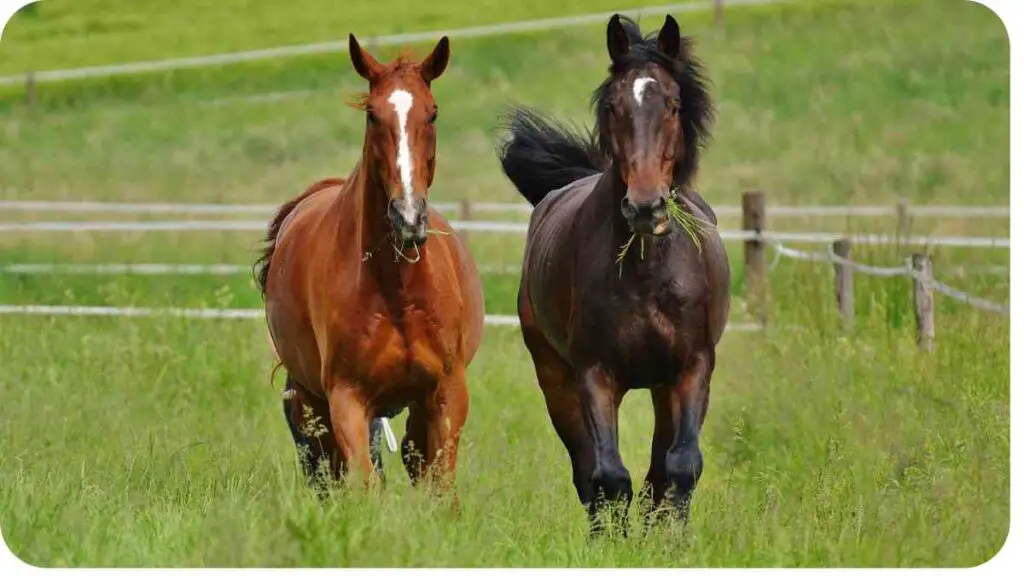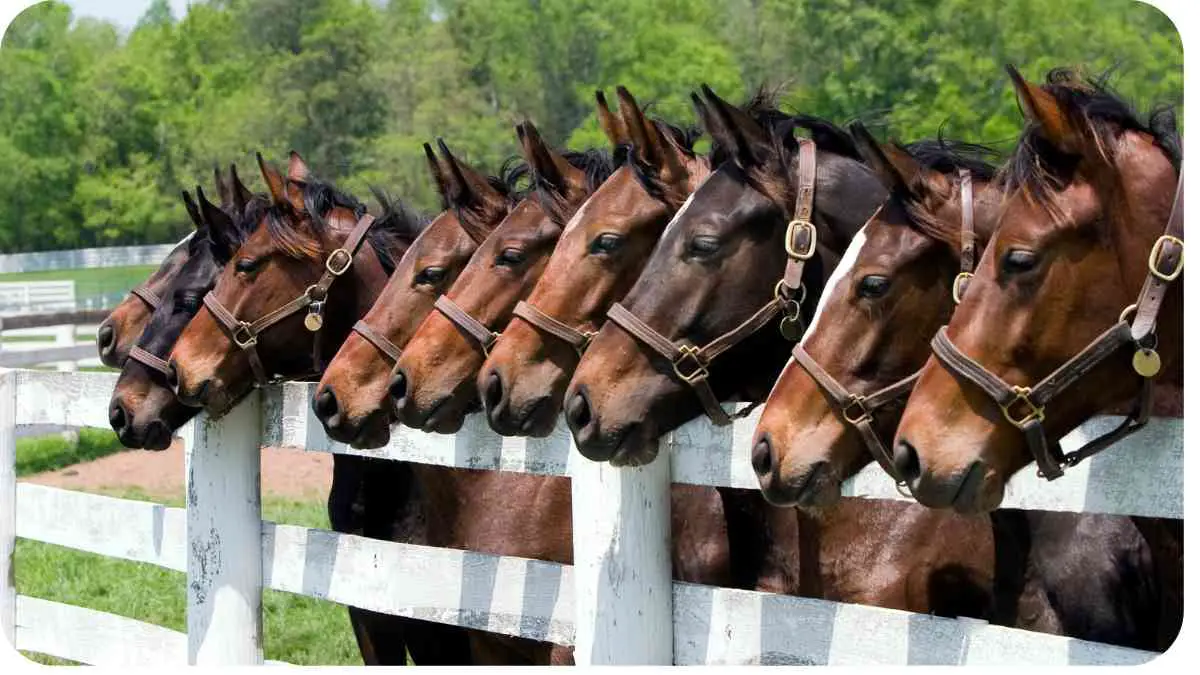As a seasoned equestrian, I’ve always been fascinated by the intricate relationship between horses and their hooves.
In this exploration of “Barefoot Beasts,” we delve into the historical journey of horses before the advent of horseshoes. Join me as we uncover the evolution of horses’ hooves and the contemporary movement advocating for barefoot horse care.
| Takeaways |
|---|
| 1. Natural Hoof Functions: Horses’ hooves have evolved for weight distribution, shock absorption, circulation, and traction. |
| 2. Historical Horseshoe Evolution: Explore the origins of horseshoeing, early materials used, and the transition to shod horses. |
| 3. Impact of Horseshoes: Learn about common hoof problems in shod horses and the arguments against constant shoeing. |
| 4. Barefoot Movement: Discover the benefits of barefoot living, famous barefoot horses, and how to transition your horse. |
| 5. Maintaining Barefoot Hooves: Understand the importance of nutrition, regular hoof care, and debunk common myths. |
| 6. Role of Farriers: Explore how farriers contribute to barefoot horse care and the collaborative approaches for equine wellness. |
| 7. Challenges and Controversies: Learn about criticisms, ongoing research, and the personal stories of barefoot success and challenges. |
| 8. Transitioning Tips: Gain insights into transitioning your horse to a barefoot lifestyle with gradual changes and professional guidance. |
| 9. Further Reading: Explore additional resources and articles to deepen your understanding of barefoot horse care. |
| 10. FAQs: Get answers to common questions about the feasibility, transition, terrains, nutrition, and competitive aspects of barefoot horses. |
2. The Evolution of Horses’ Hooves

2.1 Natural Hoof Functions
Let’s start by understanding the incredible design of horses’ hooves. Nature equipped these majestic creatures with hooves that served multiple functions, providing both support and shock absorption.
Exploring the natural state of hooves, learn more about the potential risks horses face when going barefoot and the importance of proper hoof care.
| Natural Hoof Functions | |
|---|---|
| Weight Distribution | Evenly disperses the horse’s weight. |
| Shock Absorption | Absorbs impact during movement, protecting joints. |
| Circulation | Promotes blood circulation within the hooves. |
| Traction | Enables secure footing on various terrains. |
2.2 Adaptations to Different Terrains
Horses evolved to traverse diverse landscapes, leading to natural adaptations in their hooves.
| Terrain Type | Hoof Adaptation |
|---|---|
| Soft Ground | Hooves expand for increased surface area and traction. |
| Rocky Terrain | Harder, more compact hooves for durability and support. |
| Arid Environments | Efficient moisture retention to prevent hoof dryness. |
3. Historical Perspectives on Horseshoes
3.1 Origins of Horseshoeing
In ancient times, horses were used primarily for war and agriculture, and the concept of protecting their hooves emerged.
| Ancient Civilizations | Early Horseshoe Practices |
|---|---|
| Romans and Greeks | Leather and metal sandals for hoof protection. |
| Celts and Druids | Ritualistic significance of horseshoes. |
3.2 Early Materials Used for Horseshoes
Materials evolved over time, with metal becoming the preferred choice for durability.
| Historical Materials | |
|---|---|
| Leather | Early attempts at protection. |
| Iron and Bronze | Emergence of metal horseshoes. |
| Modern Alloys | Contemporary materials for durability. |
4. The Transition to Shod Horses

4.1 Rise in Equestrian Activities
The use of horses expanded beyond warfare and agriculture, leading to increased demand for hoof protection.
Discover the protective benefits of rubber, explore here as an alternative for horse hoof protection, ensuring the well-being and comfort of your equine companion
| Equestrian Activities | |
|---|---|
| Cavalry Warfare | Need for durable hoof protection. |
| Transportation | Horses became integral for travel. |
| Agriculture | Enhanced efficiency in farming practices. |
4.2 Reasons for Shoeing Horses
As human reliance on horses grew, the need to safeguard their hooves became more apparent.
| Reasons for Horseshoeing | |
|---|---|
| Wear and Tear | Protection against abrasive surfaces. |
| Enhanced Traction | Improved stability in varied terrains. |
| Correcting Issues | Addressing hoof imbalances and deformities. |
5. The Impact of Horseshoes on Hoof Health
5.1 Common Hoof Problems in Shod Horses
While horseshoes offered protection, they also introduced new challenges for hoof health.
| Common Hoof Problems | |
|---|---|
| Thrush | Bacterial infection in hoof crevices. |
| Laminitis | Inflammation affecting hoof laminae. |
| Hoof Cracks | Structural issues from stress and pressure. |
5.2 Arguments Against Horseshoe Use
A growing awareness of the negative impact of constant shoeing prompted a reevaluation of traditional practices.
| Arguments Against Horseshoes | |
|---|---|
| Restricted Blood Flow | Impaired circulation in hooves. |
| Hoof Weakening | Dependency on external support. |
| Loss of Natural Functions | Reduced shock absorption and traction. |
6. Barefoot Movement in Modern Horsemanship
6.1 Benefits of Barefoot Horses
In recent years, a paradigm shift has occurred in horse care, with many enthusiasts advocating for barefoot living.
| Benefits of Barefoot Horses | |
|---|---|
| Natural Shock Absorption | Hooves flex naturally for impact absorption. |
| Improved Circulation | Unrestricted blood flow promotes hoof health. |
| Enhanced Traction | Natural grip on various terrains. |
6.2 Transitioning to Barefoot: Tips and Considerations
Transitioning a shod horse to a barefoot lifestyle requires careful consideration and gradual adjustments.
| Tips for Transitioning | |
|---|---|
| Gradual Changes | Slowly reduce shoe usage to allow adaptation. |
| Regular Monitoring | Assess hoof health during the transition. |
| Professional Guidance | Consult with a knowledgeable farrier or vet. |
7. Famous Barefoot Horses

7.1 Notable Examples of Successful Barefoot Horses
Across various disciplines, barefoot horses have showcased their resilience and performance.
Uncover the unique characteristics of donkeys’ read more hooves and why they naturally thrive without shoes, shedding light on the difference in hoof care between horses and donkeys.
| Discipline | Famous Barefoot Horse |
|---|---|
| Endurance Riding | Hidalgo, ridden by Frank T. Hopkins |
| Dressage | Totilas, under Matthias Rath |
| Eventing | La Biosthetique-Sam FBW |
7.2 Achievements and Challenges
These remarkable horses have proven that going barefoot doesn’t hinder success; in fact, it may enhance it.
| Achievements | Challenges |
|---|---|
| Improved Performance | Initial adaptation period. |
| Enhanced Hoof Health | Skepticism from traditionalists. |
8. Maintaining Healthy Barefoot Hooves
8.1 Proper Nutrition for Hoof Health
A crucial aspect of barefoot horse care is ensuring they receive the right nutrients for optimal hoof growth.
| Essential Nutrients | Role in Hoof Health |
|---|---|
| Biotin | Supports hoof structure and growth. |
| Zinc and Copper | Aids in collagen formation. |
| Omega-3 Fatty Acids | Promotes overall hoof health. |
8.2 Regular Hoof Care Practices
While barefoot horses don’t require traditional shoeing, regular maintenance is still essential.
| Hoof Care Practices | |
|---|---|
| Regular Trimming | Prevents excessive growth and imbalances. |
| Natural Wear and Tear | Encourages self-maintenance in natural environments. |
| Sole Protection | Optional boots for added protection during challenging conditions. |
9. Debunking Myths About Barefoot Horses
9.1 Addressing Common Misconceptions
Despite the growing popularity of barefoot practices, misconceptions linger.
| Common Myths | Reality |
|---|---|
| “Hooves become too soft.” | Proper nutrition and terrain adaptation maintain hoof strength. |
| “Barefoot is only for light work.” | Barefoot horses excel in various disciplines. |
9.2 Scientific Support for Barefoot Practices
Numerous studies support the benefits of barefoot living for horses, emphasizing its positive impact on overall well-being.
| Scientific Findings | |
|---|---|
| Improved Blood Flow | Studies show increased blood circulation in barefoot hooves. |
| Natural Shock Absorption | Hoof flexibility aids in reducing impact stress on joints. |
10. The Role of Farriers in Barefoot Horse Care
10.1 Farriers’ Perspective on Barefoot Hoof Maintenance
Farriers play a crucial role in supporting the well-being of barefoot horses, offering specialized care tailored to individual needs.
| Farriers’ Contributions | |
|---|---|
| Trimming Techniques | Skillful trimming for balanced hooves without shoeing. |
| Advising on Terrain | Providing guidance on suitable terrains for barefoot living. |
| Boot Fitting | Recommending and fitting protective boots when necessary. |
10.2 Collaborative Approaches for Equine Wellness
Collaboration between horse owners, farriers, and veterinarians is vital for successful barefoot horse care.
| Collaborative Approaches | |
|---|---|
| Regular Assessments | Scheduled check-ups to monitor hoof health. |
| Open Communication | Discussing any concerns or changes in the horse’s condition. |
| Continuous Education | Staying informed about the latest advancements in barefoot practices. |
11. Challenges and Controversies in the Barefoot Movement
11.1 Criticisms and Concerns
Despite its merits, the barefoot movement is not without its share of criticisms and concerns.
Gain insights into the factors determining explore now when horses need horseshoes, providing a comprehensive guide to the proper timing and considerations for this important aspect of equine care.
| Criticisms | |
|---|---|
| Limited Application | Some argue barefoot is not suitable for all horses and disciplines. |
| Transition Challenges | Owners may face difficulties during the initial adaptation phase. |
11.2 Ongoing Research and Developments
To address concerns and improve practices, ongoing research is exploring new dimensions of barefoot horse care.
| Research Initiatives | |
|---|---|
| Hoof Health Studies | Investigating the long-term impact of barefoot living on hoof health. |
| Performance Analysis | Assessing the performance of barefoot horses in various disciplines. |
12. Personal Stories: Barefoot Success and Challenges
12.1 Testimonials from Horse Owners
Real-world experiences from horse owners highlight the diverse journeys of transitioning to and maintaining barefoot horses.
| Horse Owner Testimonials | |
|---|---|
| Improved Performance | Notable enhancements in agility and endurance. |
| Healthier Hooves | Positive changes in hoof quality and overall well-being. |
12.2 Overcoming Barefooting Obstacles
Acknowledging challenges is essential, and learning from others’ experiences can provide valuable insights.
| Challenges Faced | Strategies for Overcoming |
|---|---|
| Initial Discomfort | Gradual transitions and patience during adaptation. |
| Skepticism from Peers | Sharing success stories and educating others on the benefits. |
13. Tips for Transitioning Your Horse to Barefoot
13.1 Gradual Changes and Monitoring
Transitioning to a barefoot lifestyle is a process that requires patience and attentive monitoring.
Delve into the intriguing exploration of learn about it horses’ perspective on being fitted for shoes, offering insights into the age-old practice of horseshoeing and its impact on equine well-being.
| Transition Tips | |
|---|---|
| Gradual Removal of Shoes | Incremental reduction to allow hooves to adjust. |
| Regular Hoof Checks | Monitor for any signs of discomfort or imbalance. |
13.2 Professional Guidance and Support
Seeking guidance from professionals is crucial for a successful transition.
| Professional Assistance | |
|---|---|
| Farrier Consultation | Collaborate with a farrier experienced in barefoot care. |
| Veterinarian Input | Consult with a veterinarian to address any health concerns. |
14. Conclusion
In conclusion, the journey of “Barefoot Beasts” takes us through the rich history of horses and their hooves. From the natural functions of hooves to the evolution of horseshoes and the contemporary barefoot movement, this exploration highlights the complexities of equine care.
We’ve uncovered the benefits of barefoot living, showcased famous barefoot horses, and debunked common myths surrounding this practice. The role of farriers, collaborative approaches for equine wellness, and ongoing research emphasize the dynamic nature of horse care.
Personal stories from horse owners underscore the successes and challenges of transitioning to barefoot living. With proper nutrition, regular hoof care, and professional guidance, the journey to barefoot can lead to improved performance and overall hoof health.
Further Reading
- The Mythical Barefoot Horse: Explore the mystical aspects of barefoot horse care in this engaging post. Learn about the myths and truths surrounding this natural approach.
- Can Horses Go Barefoot?: Delve into the considerations and possibilities of transitioning horses to a barefoot lifestyle. This resource offers insights into the feasibility and benefits of barefoot living.
- The Barefoot Equine Athlete: Big Shoes to Fill: Discover the challenges and triumphs of barefoot equine athletes. This article explores the journey of horses thriving without traditional shoes and the athletic achievements they can attain.
FAQs
Can any horse go barefoot?
Yes, in general, most horses can transition to a barefoot lifestyle. However, individual factors such as hoof health, terrain, and workload should be considered. Consulting with a farrier or veterinarian can provide personalized advice.
How do I transition my horse to a barefoot lifestyle?
Transitioning to barefoot requires a gradual approach. Start by reducing shoe usage, monitoring hoof health, and providing proper nutrition. Professional guidance from a knowledgeable farrier or vet is crucial during this process.
Are there specific terrains that are better for barefoot horses?
Barefoot horses can thrive on various terrains, but softer surfaces initially support the transition. Natural terrains like grassy fields or arenas are ideal. Hard and rocky surfaces may require protective boots.
What nutritional considerations are important for barefoot horse health?
Nutrients like biotin, zinc, copper, and omega-3 fatty acids contribute to overall hoof health. Ensuring a balanced diet that supports these essential nutrients is crucial for barefoot horses.
Can barefoot horses participate in competitive disciplines?
Yes, many barefoot horses excel in competitive disciplines such as endurance, dressage, and eventing. Proper conditioning, regular hoof care, and attentive monitoring contribute to their success.

Hi there! My name is Hellen James, and I’m a horse riding expert. I’ve been riding horses since I was just a kid—and it’s been my passion ever since. But getting started with horse riding can be overwhelming. There’s so much to learn! If you’re looking for a way to get started and make sure you’re doing it right, I’m here to help.


